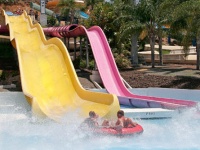
Aqualand is a must for all families visiting Gran Canaria, especially those with children. The wide range of slides, pools, and rides will keep the young and the young at heart happily entertained for hours. Those looking for an injection of adrenalin should try the wide array of thrill rides, while young children have their own water playground with fun mini slides and swings. There is a surf beach and a lazy river which families can enjoy together, while there are plenty of benches and beach areas for relaxing and picnicking. Lockers and sun loungers cost a little extra, but visitors do get free bags to keep their towels and other belongings in. The park is clean and well-maintained, generally receiving rave reviews from tourists. It is open all year, but does close if the weather is very bad. Queues are usually not too long, but it is worth arriving early in the day in peak season to get a jump on the crowds.
Address : Ctra. Palmitos Park, Km 3
Website : www.aqualand.es
Telephone : +34 928 140 525
Opening times : 10am to 5pm (September to June); 10am to 6pm (July to August).
Admission : €29 (adults); €20 (children aged 5 - 10); €12 (children aged 3 - 4). Family package deals available. Discounts for booking online.
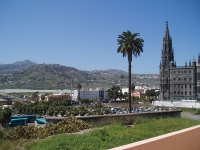
The delightful town of Arucas sits beneath a dormant volcano on the northern coast of Gran Canaria, and is one of the most popular places for tourists to visit. The neat town is dominated by the majestic Church of San Juan Bautista, carved in stone by local workers. It is possible to take a short walk out of the town to the Montana de Arucas viewpoint for a panoramic look at the northern coastline. The town is scenically situated, surrounded by fields of corn and potatoes and banana plantations, and the Palmitos ravine provides some beautiful vistas. The stunning, UNESCO-listed Gran Canaria Biosphere Reserve is also easily accessible from Arucas. The town is very close to the city of Las Palmas de Gran Canaria. The city has numerous historical attractions as well as the pleasures of sun, sea, and watersports, and is one of the main travel hubs in the region. Arucas is therefore a great excursion from the city, providing a bit of rural charm as a break from the urban glories of Las Palmas.
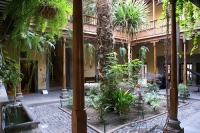
Christopher Columbus is believed to have stayed for different periods in the Casa de Colon, in the historical quarter of Vegueta in Las Palmas. The house now serves as a museum displaying relics of early transatlantic voyages and pre-Columbian cultures, as well as acting as a cultural centre for the study of the Canary Island's relationship with the Americas. The building is a famous example of the architecture of the Canary Islands, with heavy wooden balconies, patios, fountains, and some unusual ornamental features. It was once the residence of Las Palmas's early governors. There are now 13 permanent exhibition halls, a library, and a research centre, containing fascinating artefacts and even some colourful parrots among the palm trees in the courtyards. Although competition is not steep in the city, Casa de Colon is probably the most popular museum in Las Palmas and generally receives rave reviews from visitors. The museum is situated next to the cathedral and is worth an hour or two of sightseeing time in the city.
Address : Columbus Street, Las Palmas
E-mail : [email protected]
Website : http://www.casadecolon.com
Telephone : +34 928 312 373
Opening times : Monday to Friday from 9am to 7pm; weekends from 9am to 3pm
Admission : €4 (general), €2 (reduced).
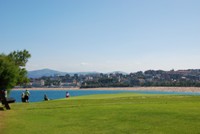
There are a number of world-class golf courses on Gran Canaria, including Meloneras Golf Course, and golf is a popular activity in the Canary Islands. El Cortijo was home to the Spanish Open in 2002 and is just outside Las Palmas. The Real Club de Golf is nearby in Bandama and is Spain's oldest golf club, founded in 1891; it is closed to non-members at weekends. The Maspalomas Club de Golf is located close to the sand dunes within a nature reserve, while the newest club, Salobre, is just 10 minutes drive east of Puerto Rico. Other notable golf courses on Gran Canaria include Las Palmeras Golf, Oasis Golf, Anfi Tuaro Golf, and Meloneras Golf. Las Palmeras Golf Course is located in the city centre and boasts views over the Atlantic Ocean and the picturesque Canteras beach. The Oasis Golf Course in Autopista del Sur is a quirky miniature copy of famous American courses and many consider it to be one of the best replicas in the world. It also has floodlights. The Anfi Tuaro Course in Mogan features both a pitch-and-putt course of 9 holes and a par-72 18-hole course complete with lakes, flowers, and spectacular mountain views.
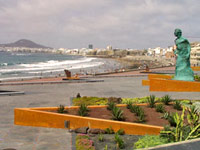
The capital of Gran Canaria and a bustling holiday resort, Las Palmas is situated on the northeastern tip of the island, between two long and lovely stretches of beach. The city was founded in 1478 and was the spot where Christopher Columbus began each of his voyages to the Americas. Much of the historic Vegueta district remains charmingly intact behind the modern apartment blocks which line the seafront, and there are many interesting ancient sights and museums to visit. Interesting cultural offerings, fun festivals, and highly renowned cuisine attracts thousands of holidaymakers to Las Palmas every year. Of course, the surrounding stretches of beach are also a big draw card, as is the fact that the city is the gateway to the whole island. The warm waters surrounding Las Palmas provide perfect conditions for all kinds of watersports for holidaymakers, including sailing and boating. Many of the resorts also have their own tennis courts, golf courses, and other sporting facilities. Whale watching is a popular activity and tickets can be bought from companies taking tourists out on boats for the day. Las Palmas promises some good holiday shopping and the city also lures travellers with an energetic nightlife.
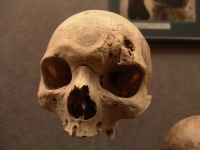
The Museo Canario boasts mummies and the world's largest collection of Cro-Magnon skulls. The permanent exhibition is devoted solely to the aboriginal population of Gran Canaria, who inhabited the islands from the second half of the first millennium BC up until the 15th century. It covers things like religion and mythology, funerary practices, economic activity, and the organisation of society. The award-winning museum in Las Palmas houses the most complete and comprehensive archaeological collection in the Canary Islands and should be of great interest to anybody keen on archaeology, anthropology, and the ancient history of the Canary Islands. There is a room full of the skeletal remains of the ancients, which is spooky but fascinating. The information provided in the exhibitions is invariably only in Spanish, but at the entrance you should be given a booklet explaining the displays in your own language. The museum is popular with tourists and is one of the top-rated attractions in Las Palmas.
Address : 2 Verneau Dr.
E-mail : [email protected]
Website : www.elmuseocanario.com
Telephone : +34 928 336 800
Opening times : Monday to Friday from 10am to 8pm, weekends from 10am to 2pm.
Admission : €5 (adults); children under 12 free; concessions available. Free entry on Mondays.
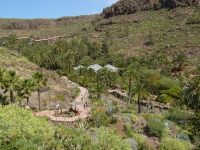
A colourful and entertaining look at nature is presented at Palmitos Park, a botanical garden, zoo, and aquarium situated four miles (6km) inland from Arguineguin on the south coast. The park is a subtropical oasis containing thousands of birds, fish, animals, trees, plants, and particularly orchids. The orchid house is the largest in the Canary Islands and the range is astonishing. There is a cactus garden too, a huge butterfly house, and an aquarium featuring a recreated riverbed. Attractions include dolphin shows and a number of bird shows including displays by birds of prey, parrots, and exotic birds. The park also houses a selection of reptiles and other animals including aardvarks, wallabies, and meerkats. Another highlight is Primate Island, which is inhabited by entertaining gibbons and orangutans. There are numerous picnic spots and view points in the park, which is blessed with some ruggedly beautiful scenery. There are also cafes selling refreshments for those who don't bring their own food. All displays and shows are included in the entrance fee. Check the official website listed below to see what time all the different animals perform. There is a substantial reduction for online booking via the website.
Website : www.palmitospark.es
Telephone : +34 928 140 276
Opening times : Daily from 10am to 6pm (last admission at 5pm).
Admission : €29 (adults); €21,50 (children aged 5 - 10); €8 (children aged 3 - 4).
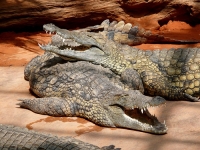
This crocodile park is home to more than 300 crocodiles and alligators from all over the world. Visitors shouldn't miss the crocodiles' feeding times, which occur daily at about 12pm, 2pm, and 4.15pm, during which the animals are at their most active. The other half of the park is a zoo, which houses other reptiles, various birds, monkeys, chimpanzees, tigers, jaguars, camels, and more. There is a restaurant in the centre of the park where visitors can see a show where parrots perform various tricks, while the educational crocodile show is the main attraction. The park is near the town of Aguímes, a few miles southwest of the airport. Those with a soft spot for reptiles should also consider visiting Reptilandia, situated a little off the beaten track near Agaete, in the northwest of the island. This park houses a collection of snakes, tortoises, turtles, spiders, monkeys, and lizards. The Komodo Dragon here is believed to be the largest lizard in the world. Kids are bound to love both attractions, and they are good options for families wanting a short break from the beach.
Address : Villa de Aguímes.
Telephone : +34 928 784 725
Transport : Hourly bus between 9am and 3pm from near the fun fair in Maspalomas. Alternatively, the park operates a service from Puerto Rico, picking up outside the Jamaica Supermarket, at 10.30am on Thursdays and Sundays
Opening times : Sunday to Friday from 10am to 6pm
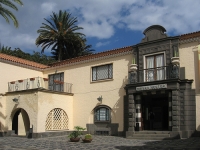
The whitewashed Pueblo Canario was the pet project of Canarian artist Nestor Martin-Fernandez de la Torre, who conceived and oversaw the creation of this idealised representation of a typical island village next to Dorames Park, Las Palmas. Buildings surround a square where performances of folk music and dance take place every Sunday morning. The dancers and musicians dress up in full traditional garb and use traditional instruments. Those who just want to enjoy the free music and show can sip on a beer or a coffee in the pleasant square, or have a meal at the restaurant. The village also contains the Museo Nestor, in which is housed a collection of the artist's modernist paintings, a playground for children, and some handicraft shops where visitors can pick up some souvenirs. The entertainment is simple and old-fashioned and the village is picturesque and worth strolling around, especially in combination with the park that borders it. Pueblo Canario gives travellers a taste of rural Canarian culture and charm in the middle of the city. The best time to visit by far is on Sunday mornings.
Opening times : Tuesday to Friday from 10am to 8pm, Sundays from 10.30am to 2.30pm

Travel Guide powered by Word Travels, copyright © 2023 Globe Media Ltd. By its very nature information in this travel guide is subject to change at short notice and travellers are urged to verify information on which they're relying with the relevant authorities. Neither Globe Media Ltd nor Travel Vogue can accept any responsibility for any loss or inconvenience to any person as a result of information contained above.